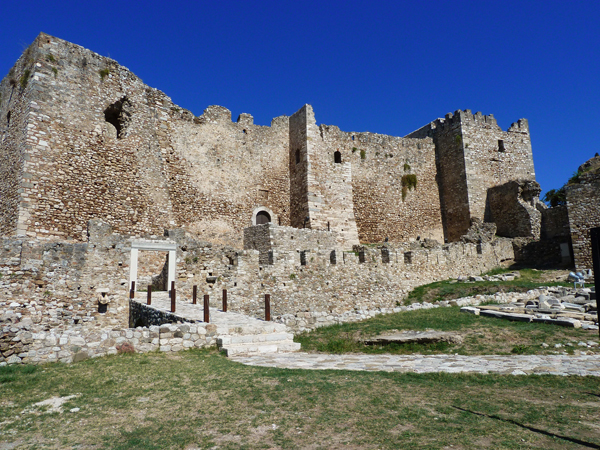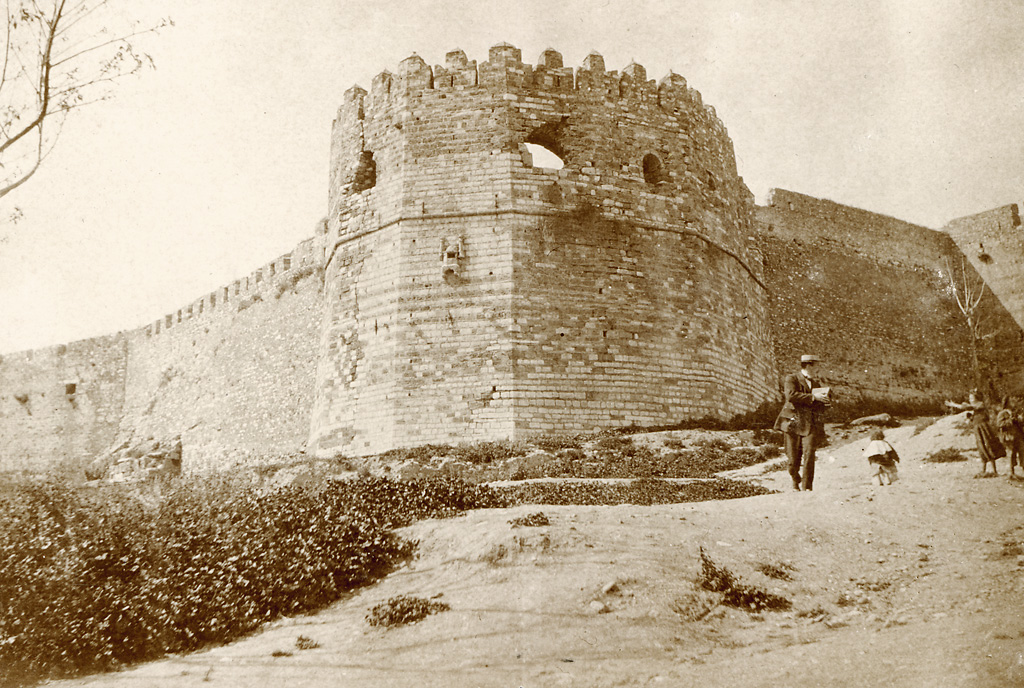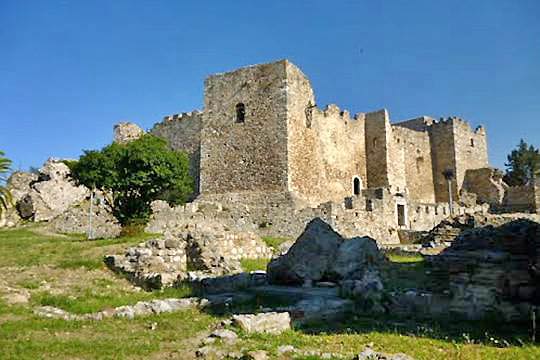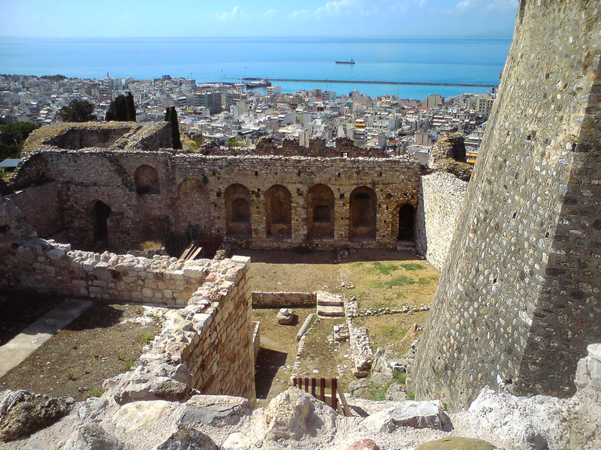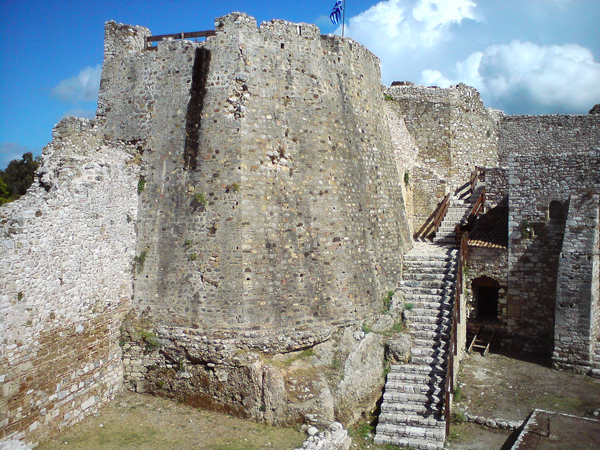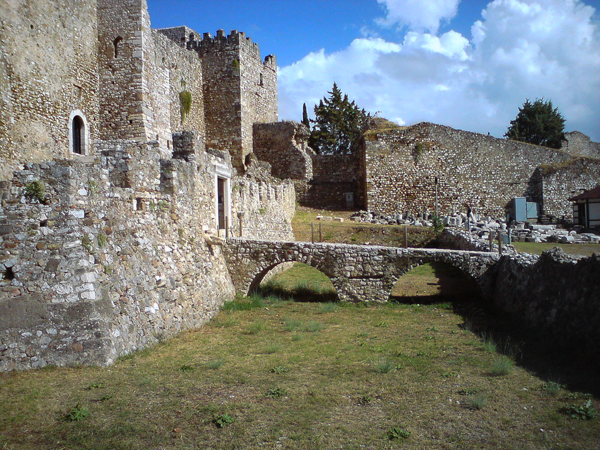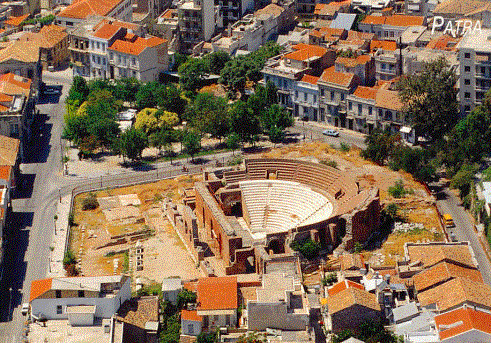
Home Destinations Patras Region Patras
Patras
Patras is Greece's third largest city and the regional capital of Western Greece and is situated in northwestern Peloponnese about 200 km west of Athens. Dubbed as Greece's Gate to the West, Patras is a commercial hub, with a busy port, with 3 universities, hosting a large student population and rendering Patras a major scientific center with a field of excellence in technological education.
Patras Overview
Part I:
Patras History
The city of Patras has an important history of four thousand years. Patras has been inhabited since the prehistoric age and constituted an important centre of the Mycenean era. In the antiquity it was a leading member of the Achaean League. Patras reached the peak of its power in the Roman era, when an imperial colony was founded there by Augustus. In the Byzantine period it remained a commercial city. The town experienced repeated conquests from Latins, Venice, Francs, Byzantines and Ottomans. Later on, it played a leading part in the Greek revolution of 1821, the first revolt of which in Greece, broke out in Patras. In 19th century Greece, it was the second city of the country, the indisputable centre of the Peloponnese, an important export harbour and a cradle of the emerging Greek middle class. In the 20th century the city developed as a commercial and industrial hub and in spite of its overshadowing by Athens, it is now the third city of Greece and the most significant economic pole of Peloponnese and West Greece.
Antiquity
Domine lorem ipsum dolor sit amet, consectetuer adipiscing elit. Aenean commodo ligula eget dolor. Aenean massa. Cum sociis natoque penatibus et magnis dis parturient montes, nascetur ridiculus mus. Donec quam felis, ultricies nec, pellentesque eu, pretium quis, sem. Nulla consequat massa quis enim. Donec pede justo, fringilla vel, aliquet nec, vulputate eget, arcu. In enim justo, rhoncus ut, imperdiet a, maecenas ullamcorper, dui et placerat feugiat, eros pede varius nisi, condimentum viverra felis nunc et lorem. Sed magna purus, fermentum eu, tincidunt eu, varius ut, felis. In auctor lobortis lacus. Quisque libero metus, condimentum nec, tempor a, commodo mollis, magna. Vestibulum ullamcorper mauris at ligula. Fusce fermentum. Nullam cursus lacinia erat. Praesent blandit laoreet nibh.
Medieval Times
Domine lorem ipsum dolor sit amet, consectetuer adipiscing elit. Aenean commodo ligula eget dolor. Aenean massa. Cum sociis natoque penatibus et magnis dis parturient montes, nascetur ridiculus mus. Donec quam felis, ultricies nec, pellentesque eu, pretium quis, sem. Nulla consequat massa quis enim. Donec pede justo, fringilla vel, aliquet nec, vulputate eget, arcu. In enim justo, rhoncus ut, imperdiet a, maecenas ullamcorper, dui et placerat feugiat, eros pede varius nisi, condimentum viverra felis nunc et lorem. Sed magna purus, fermentum eu, tincidunt eu, varius ut, felis. In auctor lobortis lacus. Quisque libero metus, condimentum nec, tempor a, commodo mollis, magna. Vestibulum ullamcorper mauris at ligula. Fusce fermentum. Nullam cursus lacinia erat. Praesent blandit laoreet nibh.
Ottoman Era
Domine lorem ipsum dolor sit amet, consectetuer adipiscing elit. Aenean commodo ligula eget dolor. Aenean massa. Cum sociis natoque penatibus et magnis dis parturient montes, nascetur ridiculus mus. Donec quam felis, ultricies nec, pellentesque eu, pretium quis, sem. Nulla consequat massa quis enim. Donec pede justo, fringilla vel, aliquet nec, vulputate eget, arcu. In enim justo, rhoncus ut, imperdiet a, maecenas ullamcorper, dui et placerat feugiat, eros pede varius nisi, condimentum viverra felis nunc et lorem. Sed magna purus, fermentum eu, tincidunt eu, varius ut, felis. In auctor lobortis lacus. Quisque libero metus, condimentum nec, tempor a, commodo mollis, magna. Vestibulum ullamcorper mauris at ligula. Fusce fermentum. Nullam cursus lacinia erat. Praesent blandit laoreet nibh.
Modern Times
Domine lorem ipsum dolor sit amet, consectetuer adipiscing elit. Aenean commodo ligula eget dolor. Aenean massa. Cum sociis natoque penatibus et magnis dis parturient montes, nascetur ridiculus mus. Donec quam felis, ultricies nec, pellentesque eu, pretium quis, sem. Nulla consequat massa quis enim. Donec pede justo, fringilla vel, aliquet nec, vulputate eget, arcu. In enim justo, rhoncus ut, imperdiet a, maecenas ullamcorper, dui et placerat feugiat, eros pede varius nisi, condimentum viverra felis nunc et lorem. Sed magna purus, fermentum eu, tincidunt eu, varius ut, felis. In auctor lobortis lacus. Quisque libero metus, condimentum nec, tempor a, commodo mollis, magna. Vestibulum ullamcorper mauris at ligula. Fusce fermentum. Nullam cursus lacinia erat. Praesent blandit laoreet nibh.
Part II:
Patras Geography
Domine lorem ipsum dolor sit amet, consectetuer adipiscing elit. Aenean commodo ligula eget dolor. Aenean massa. Cum sociis natoque penatibus et magnis dis parturient montes, nascetur ridiculus mus. Donec quam felis, ultricies nec, pellentesque eu, pretium quis, sem. Nulla consequat massa quis enim. Donec pede justo, fringilla vel, aliquet nec, vulputate eget, arcu. In enim justo, rhoncus ut, imperdiet a, venenatis vitae, justo. Curabitur a felis in nunc fringilla tristique. Morbi mattis ullamcorper velit. Phasellus gravida semper nisi. Nullam vel sem. Pellentesque libero tortor, tincidunt et, tincidunt laoreet nibh.
Historic Center
Domine lorem ipsum dolor sit amet, consectetuer adipiscing elit. Aenean commodo ligula eget dolor. Aenean massa. Cum sociis natoque penatibus et magnis dis parturient montes, nascetur ridiculus mus. Donec quam felis, ultricies nec, pellentesque eu, pretium quis, sem. Nulla consequat massa quis enim. Donec pede justo, fringilla vel, aliquet nec, vulputate eget, arcu. In enim justo, rhoncus ut, imperdiet a, maecenas ullamcorper, dui et placerat feugiat, eros pede varius nisi, condimentum viverra felis nunc et lorem. Sed magna purus, fermentum eu, tincidunt eu, varius ut, felis. In auctor lobortis lacus. Quisque libero metus, condimentum nec, tempor a, commodo mollis, magna. Vestibulum ullamcorper mauris at ligula. Fusce fermentum. Nullam cursus lacinia erat. Praesent blandit laoreet nibh.
Upper Town
Domine lorem ipsum dolor sit amet, consectetuer adipiscing elit. Aenean commodo ligula eget dolor. Aenean massa. Cum sociis natoque penatibus et magnis dis parturient montes, nascetur ridiculus mus. Donec quam felis, ultricies nec, pellentesque eu, pretium quis, sem. Nulla consequat massa quis enim. Donec pede justo, fringilla vel, aliquet nec, vulputate eget, arcu. In enim justo, rhoncus ut, imperdiet a, maecenas ullamcorper, dui et placerat feugiat, eros pede varius nisi, condimentum viverra felis nunc et lorem. Sed magna purus, fermentum eu, tincidunt eu, varius ut, felis. In auctor lobortis lacus. Quisque libero metus, condimentum nec, tempor a, commodo mollis, magna. Vestibulum ullamcorper mauris at ligula. Fusce fermentum. Nullam cursus lacinia erat. Praesent blandit laoreet nibh.
Patras Overview
HISTORY
Antiquity
Medieval Times
Ottoman Era
Modern Times
GEOGRAPHY
Historic Center
Upper Town
Sights & Places
MUSEUMS
Archaeological Museum of Patras
The New Archaeological Museum of Patras is located in the city of Patras, Greece. It opened on July 24, 2009. Built on a 28,000-square-metre (300,000 sq ft) plot of land, with 8,000 square metres of interior spaces, it is the second-largest museum of Greece. The area surrounding the museum comprises a 500-square-metre (5,400 sq ft) pool, a shiny metallic dome and greenery. In the near future, the vacant land next to the museum will be turned into a cultural park.
It houses collections about the history of Patras and the surrounding area from prehistory to the end of Roman times. The museum was designed by the architect Mr. Theofanis Bobotis with an original cost of 21.5 million euros that ended up at a total of 25 million. It was originally planned to open in 2006, when Patras was the cultural capital of Europe, but despite the construction being ready, the structure remained empty, with the opening being delayed several times.
The museum has four thematic sections, three of which permanent and one periodic. From the three permanent, currently only two are open to the public with the third expected to be opened by the end of the year.[when?] The periodic section will be hosting various exhibitions around the year. According to the archaeologists of the 6th Antiquity Conservancy, the 70% of the items exhibited are seeing the light of day for the first time in the past thirty years. The museum is open daily from 8 am till 3 pm, except Monday; entrance is currently 4 euro (August 2011).
Sight Information
-
Category:
Museum
-
Location:
Anthoupoli, Patras
-
Address:
National Road of Patras-Athens 38-40, Anthoupoli, Patras
-
Phones:
-
Websites:
-
Opening Hours:
08:00-20:00 (Tue - Sun)
closed (Mon, Holidays)
-
Ticket Prices:
€ 4.00 (regular)
€ 2.00 (students)
Folk Art Museum of Patras
https://en.wikipedia.org/wiki/Folk_Art_Museum_of_Patras
History & Ethnology Museum of Patras
Press Museum of Patras
SIGHTS
Castle of Patras
The Patras Castle (Greek: Κάστρο Πατρών) was built around the mid-6th century above the ruins of the ancient acropolis, on a low outlying hill of the Panachaiko Mountain and ca. 800 m from the sea. The castle covers 22,725 m² and consists of a triangular outer wall, strengthened by towers and gates and further protected originally by a moat, and an inner compound on the northeastern corner, also protected by a moat. The castle was built by Byzantine emperor Justinian I after the catastrophic earthquake of 551, re-using building material from pre-Christian structures. One of these spolia, the torso and head of a marble Roman statue, became part of the city’s folklore, a sort of genius loci. It is known as the “Patrinella”, a maiden who is supposed to have been transformed into a man during Ottoman times, guards the city against disease and weeps whenever a prominent citizen of Patras dies.
The fort remained in constant use thereafter, even until the Second World War. In the Byzantine period, it was besieged by Slavs, Saracens, Normans and many others, but it never fell. In particular, the successful repulsion of a great siege of 805 AD by the Arabs and the Slavs was attributed to the city’s patron saint, St Andrew. In 1205, in the aftermath of the Fourth Crusade, it was taken over by the Franks, who strengthened it further, opening a moat on all three sides. In 1278, the Principality of Achaea pawned it to the local Latin (Catholic) Archbishop, while the Pope leased it to the Venetians for five years in 1408. The Latin Archbishop remained in possession of the castle until 1430, when it was taken by the Despot of the Morea and future last Byzantine emperor, Constantine Palaiologos, who made extensive repairs to its walls. The castle fell to the Ottoman Turks in 1458, and remained one of their main seats of power in the Peloponnese throughout the Tourkokratia. The Venetians took the castle in 1687 during the Morean War, and kept it until the Morea was retaken by the Turks in 1715.
During the Greek War of Independence, the castle resisted all attempts of the Greek rebels to storm it. Only in 1828, with the arrival of a French expeditionary force under General Nicolas Joseph Maison, did the Ottomans hand it over. Following independence, the castle remained in use by the Greek Army until after World War II. In 1973, the castle was turned over to the 6th Ephorate of Byzantine Antiquities. It is used nowadays for cultural events, especially during summer, and features a theatre with a capacity of 640 seats.
Sight Information
-
Category:
Fortifications
-
Location:
Upper city, Patras
-
Address:
Panachaidos Athinas 10, Patras 26331, Greece
-
Phones:
-
Opening Hours:
08:00-15:00 (Tue-Sun)
closed (Mon, Holidays)
-
Ticket Prices:
free
Apollon Municipal Theater
The Apollon Theatre (Greek: θέατρο “Απόλλων Theatro Apollon) is a theatre in Patras, Greece. Designed by the famous German architect Ernst Ziller, it was completed in 1872. The Apollon is located east of Georgiou I Square, one of Patras’ popular squares. The theatre is a micrograph of the La Scala in Milan and is the oldest existing enclosed theatre of the same era. The Apollon Theatre has been the main stage of the Patras Municipal and Regional Theatre since 1988, and can hold up to 300 people.
The Apollon Theatre began construction on February 11, 1871, and opened on October 10, 1872. The construction was paid for by various residents of Patras. The main erection committee included Theodor Hamburger (president), Dimitrios Patrinos, K. Lappas and A. Chrysanthis. Other sponsors included the then-mayor of Patras, Georgios Roufos, Gustavos Clauss, Hamburger, Langouras, the Triantis Brothers, Panagiotis Brothers, father of Dimitrios Gounaris, Epameinondas Maximos, father of Dimitrios Maximos. The Apollon Theatre is one of only three neoclassic theatres that survive in Greece (the other two are the Malliaropouleio Theatre in Tripoli, which opened in 1910 and the Apollo Theatre in Syros, opened in 1864).
Roman Odeon
The Roman Odeon, the most significant ancient monument, is in the upper town and was built around 160 AD, in the reign of either Antoninus Pius or Marcus Aurelius. It has been restored and partially reconstructed, and is used as an open-air theatre for performances and concerts in the summer.
Sight Information
-
Category:
Edifice
-
Location:
Upper city, Patras
-
Address:
Palaion Patron Germanou & Sotiriadi, Patras 26225, Greece
-
Phones:
Roman Stadium
CHURCHES
Saint Andrew's Basilica
Saint Andrew of Patras (Agios Andreas, Άγιος Ανδρέας in Greek) is the Greek Orthodox in the east side of the city of Patra. Along with the old church of St. Andrew (which lies in a close distance) it constitutes a place of pilgrimage for Christians from all over the world.It is dedicated to the First-called Apostle of Christ, Saint Andrew. The construction of the church, of Greek Byzantine Style, began in 1908 under the supervision of the architect Anastasios Metaxas, followed by Georgios Nomikos. It was inaugurated 66 years later, in 1974. It covers approximately 1,800 square meters (some other sources say 2,000). It is the largest church in Greece and the third largest Byzantine-style church in the Balkans, after the Cathedral of Saint Sava in Belgrade (Serbia) and Alexander Nevsky Cathedral in Sofia (Bulgaria). Over the central dome there is a 5 meter long gold plated cross and over the other domes there are 12 smaller crosses. These crosses symbolise Jesus and His apostles. The interior of the church is decorated with marvelous Byzantine style wall paintings and mosaics.
Inside the church are kept relics of the apostle Saint Andrew, which consist of the small finger, part of the top of the cranium of the Apostle, and small portions of the cross on which he was martyred, all kept in a special shrine. The holy skull of the Apostle was sent there from St. Peter’s Basilica, Rome in September 1964, on the orders of Pope Paul VI. Cardinal Bea led the party of 15 cardinals that presented the relic to Bishop Constantine of Patras on 24 September 1964. Thousands of people (among them prime minister George Papandreou) and many Greek Orthodox bishops participated in the reception ceremony of the precious skull. After a procession through the streets of the city, the precious skull was placed in a special silver mitre inside the church. The cross of. St. Andrew was taken from Greece during the Crusades by the Duke of Burgundy. Parts of the cross were kept since Middle Ages in the church of St. Victor in Marseilles. They were returned to Patras on 19 January 1980. The cross of the apostle was presented to the Bishop of Patras Nicodemus by the Roman Catholic delegation led by cardinal Roger Etchegaray.
Sight Information
-
Category:
Church
-
Location:
Downtown Patras
-
Address:
Agiou Andreou 199, Patras 26222, Greece
-
Phones:
-
Ticket Prices:
free
Patras’ Cathedral
Catholic church of St. Andrew
SQUARES & PARKS
King George I Square
Georgiou I Square (Greek: Πλατεία Γεωργίου Αʹ) is the central square of Patras, Greece. The square is named after King George I of Greece. It is crossed by Maizonos, Korinthou and Gerokostopoulou streets. The neoclassical Apollon Theatre is situated on the northeast side of the square. The square was built under the Kapodistrias government as a part of the 1829 plans by Stamatis Voulgaris to rebuild the devastated centre of Patras after the Greek War of Independence. Unlike the old city, the new city was built according to a grid plan with several large squares. The square has been renamed several times: Dimokratias at first, then Kalamogdarti, Othonos, Kentriki, Thomopoulou, Ethniki, Palligenesias and since 1863: Georgiou I. In the square there are two fountains.
In the square there is the Apollo Theater, designed by the famous architect Ernest Ziller. In 1875 the two fountains were placed that exist today, ordered in Italy which costed the then exorbitant sum of 70,000 drachmas. These fountains were later copied and built respectively in town Leicester, England in 1879, and in Porto, Portugal in 1882. The square itself has been rebuilt many times with the last time being in 2006. It is the center of all the carnival events and a place of political gatherings and concerts. There Pericles Kalamogdartis, the then Mayor of Patras, read the first constitution of Greece in 1843 and for this reason the square later it got his name for a period.
Psila Alonia Square
https://en.wikipedia.org/wiki/Psilalonia
Queen Olga Square
https://en.wikipedia.org/wiki/Olgas_Square
The Spinney of Patras
Shopping
Cafeterias, Taverns & Restaurants
Bars & Nightclubs
Getting there
Location
Gallery
External Sites
Make your reservation now and enjoy your vacation in Greece under the Mediterranean sun. Swim and relax in wonderful beaches; dine and drink in the most inviting and spirited restaurants and bars; explore magnificent landscapes and visit fascinating places and destinations.
Nearby Sights
-
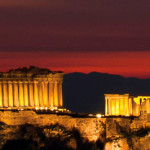
Athens
At vero eos et accusamus et iusto odio dignissimos ducimus qui blanditiis praesentium voluptatum deleniti atque corrupti …
-
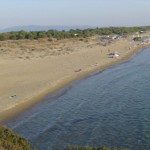
Kalogria Beach
At vero eos et accusamus et iusto odio dignissimos ducimus qui blanditiis praesentium voluptatum deleniti atque corrupti …
-

Kato Achaia
At vero eos et accusamus et iusto odio dignissimos ducimus qui blanditiis praesentium voluptatum deleniti atque corrupti …
All rights reseved











